Foundation design has traditionally been conducted using the permissible stress method with the application of a global factor of safety. With the introduction of Eurocode 7, however, a distinctive design philosophy was presented, one that is based on the application partial factors. Thus, this article aims to investigate if higher bearing capacity values can be justified to Eurocode 7.
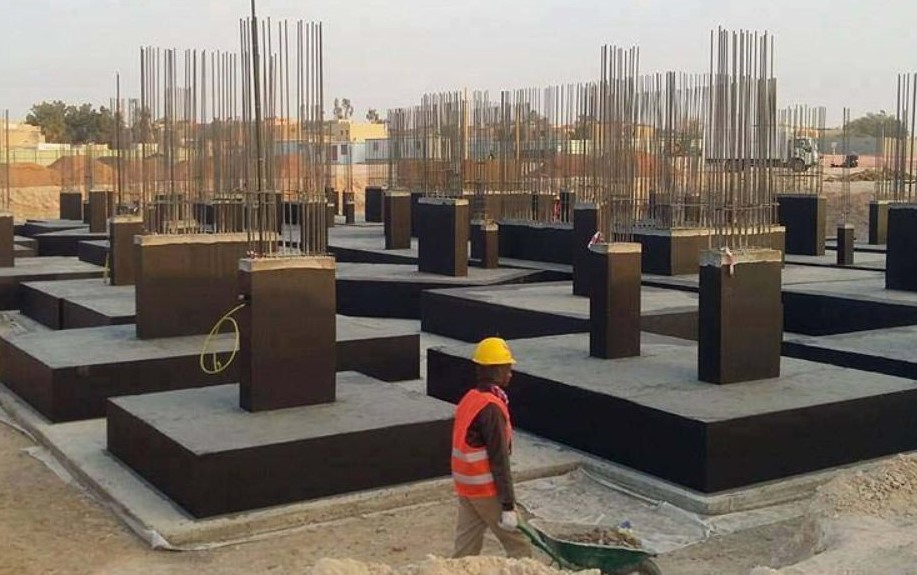
In 2010, a new set of codes for the design of civil engineering infrastructures was issued by the British Standard Institute (BSI), known as ‘The Eurocodes. The Eurocodes are a set of 10 European standards with harmonized technical rules detailing how the design of civil engineering infrastructures are to be carried out within the European Union. Conceived and developed over an extended period of three decades, they have been adjudged as the most technically advanced design codes in the world.
In several developing countries, the lack of this equivalent codes led to the adoption of codes from the developed countries. In Nigeria, the UK British Standard have been adopted over the years with the exception of nationally determined parameters. However, since the withdrawal of the British Standards there continue to be an inexplicable reluctance to fully implement the Eurocodes which have being found to be less prescriptive and flexible for use not only within the European Union but also internationally. Perhaps the opinion that “Engineers in the developing worlds have a reputation for laziness” is true. In fact, it can be postulated that the reason why we’ve not being able to develop codes of our own is not unconnected from this opinion. And there’s no easy way out disputing this, apart from the naturally inherent resistance of human beings to changes in behaviour and practices, this writer has found himself in countless exchanges where an engineer is critical about the intricacies of the Eurocodes. Some simply come up with the excuse or defense of the safety levels in the withdrawn BS standards being more appropriate for our industry.
Nonetheless, the Eurocodes are gaining some traction in Nigeria. Many designers now adopt them for structural designs, however, an area that appears completely abstracted is geotechnical design. For instance, this writer cannot comprehend why foundations are still being sized as though we were stuck somewhere, in the mid-20th century when the Austrian born engineer, Karl Terzaghi would’ve just published the famous bearing capacity equation. While this isn’t a dip at the subject, giving the very complex and imprecise nature of ground materials. Rightly so, certain aspect of geotechnical engineering has been practiced and continues to be practiced as an art till today. And until Terzaghi, the subject of geotechnical engineering relied almost exclusively on “practice and guesswork.” However, in science, 79 years is a very long time and it’s not just this writer’s opinion but a statement of fact that tremendous progress have being made on the subject.
Foundation Design Before Eurocode 7
Till the introduction of “Eurocode 7: Geotechnical Design of Structures,” geotechnical design has been carried out using the permissible stress design philosophy. What does this mean? For instance, to determine the design bearing capacity of a pad footing, the ultimate bearing capacity would be determined first, and then a global factor of safety is applied to obtain a safe bearing capacity value.
It is fascinating to search through CP 2004 and even BS 8004, the predecessors of Eurocode 7 and find that these codes aren’t only silent on recommended values for global factor of safety, but also precludes an actual calculation model for estimating bearing capacity. Instead, it recommends the concept of presumed bearing capacity, where a designer chooses a value from a given range based on soil types (See Figure 1). Thus, the concept of presumed bearing capacity is very prescriptive, in other words does not require geotechnical testing or an actual calculation be carried out, as it’s entirely based on experience and the discretion of the designer. Prescriptive measures can be adopted for conventional structures. They can be used to produce fast and conservative designs especially in cases where the cost of conducting an extensive site investigation cannot be justified. But, since ‘presumed’ values are conservative, they sometimes produce relatively uneconomical designs, hence, many designers prefer conducting a site investigation to get the benefits that comes with determining the ‘actual’ bearing capacity.’
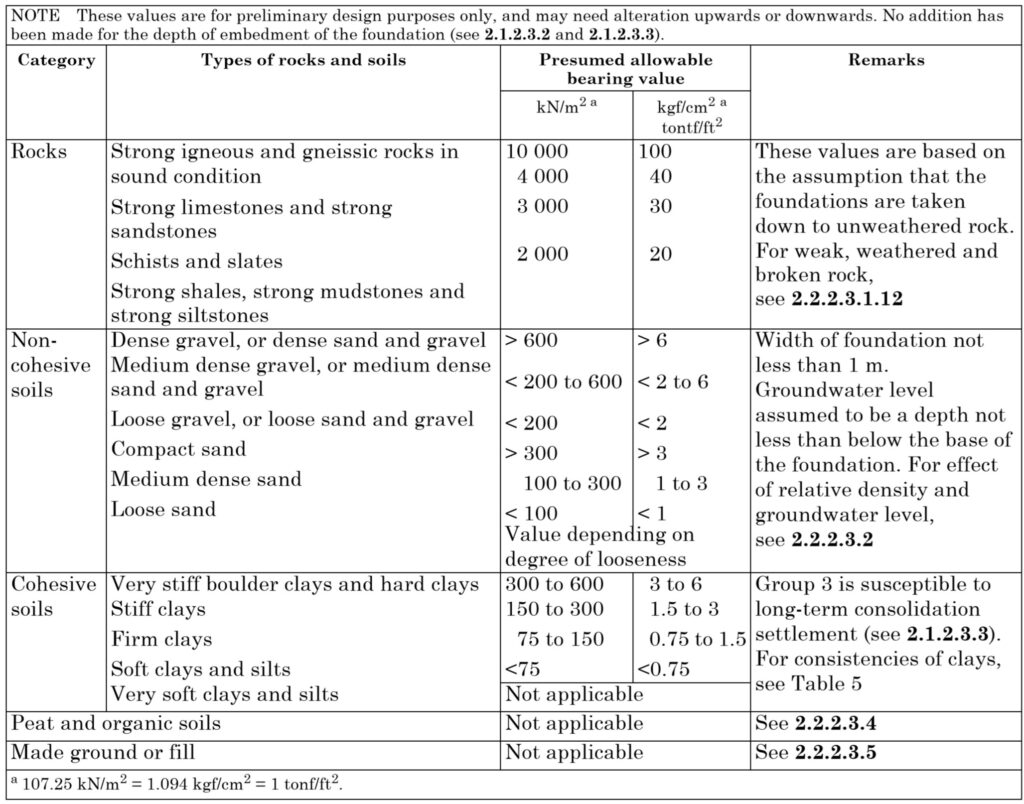
BS 8004 states that where bearing capacity is being estimated using the Terzaghi equation in standard soil mechanics texts, a suitable factor of safety, left exclusively to the discretion of the designer, be applied to determine the safe bearing capacity. However, since BS 8004 which is supposedly the head-code for geotechnical design in Nigeria doesn’t contain a ‘specified’ value, it begs the question of where the typical values of 2.5 – 3.0 found in our geotechnical investigation reports stems from. More importantly, it raises the question of whether these values can be considered to be reasonable and appropriate for every cases.
Indeed, the principal factor influencing the global factor of safety value is settlement. A foundation will not only fail from shear alone but also from excessive ground deformation, hence a judicious value of 3.0 can be said to ensure that bearing pressures are kept at very acceptable levels, without a further requirement to separately assess ground deformations. However, it is this writer’s opinion, that this approach is not just rudimentary but it is just a few steps away from the “guesswork” alluded to earlier. We now have a code that does better and we also have commercial software that can deal with the complexities of estimating settlement.
A Review of Eurocode 7
In sharp contrast to BS 8004, Eurocode 7 adopts a completely divergent design philosophy – the Limit State Design. Here partial factors are applied to both actions or their effects and material parameters. Eurocode 7 provides a design philosophy that allows designers to make reliable allowance for uncertainties by applying separate partial factors to actions, ground properties and material strength based on their individual degree of uncertainty, as opposed to the application of a global factor of safety. The ultimate result is that geotechnical designs carried out to Eurocode 7 not only have an acceptable and consistent reliability of performance but also the fact that foundations sized to Eurocode 7 can be sensibly economical when compared to those of the past.
Eurocode 7 is composed of two parts; Eurocode (part 1) also referred to as EN 1997-1 which sets out the principles and application rules for conducting geotechnical design and Eurocode 7 (part 2) which provides the requirement for ground investigation and the derivation of various soil parameters from soil tests.
Within Eurocode 7, there are four main methods of conducting geotechnical designs, these include, design by calculation, design by observation, design by testing and design by prescriptive measures. All four methods are equally valid and based on the assumption that no limit state is exceeded; however, some methods might produce more efficient and economical solution than others depending on the accuracy of the data available and the risk and complexity of the design. Talking about risk and complexity, Eurocode 7 recommends three Geotechnical categories that could be used in assessing risk and expected design method when undertaking a geotechnical design (See figure 2).
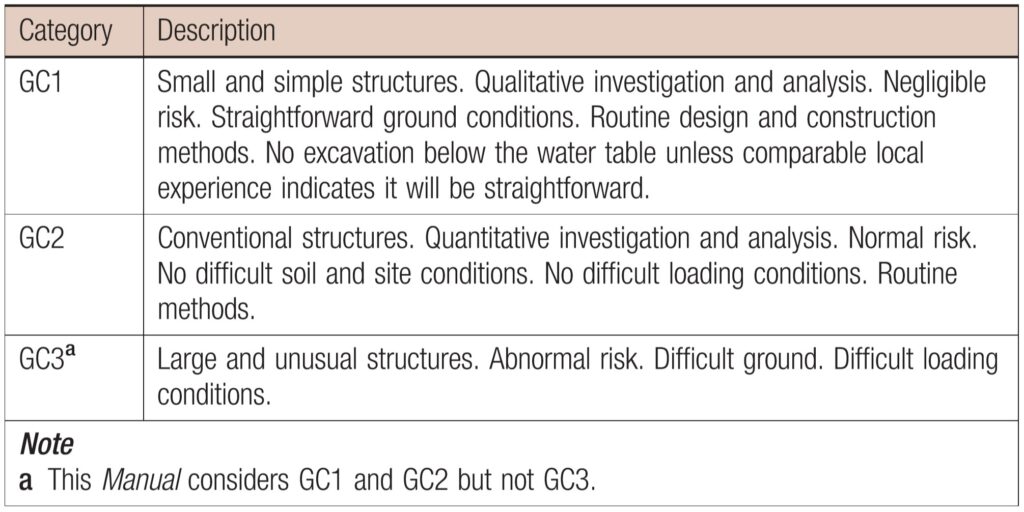
Geotechnical Design by Testing
Geotechnical Design by testing involves a design conducted through small- or large-scale model tests on site to justify the geotechnical design. The typical pile load tests, where the load carrying capacity of each pile is determined in real time is an example of design by testing. Design by testing provides unique results, which when compared with those from site investigations are found to be more accurate. This approach to foundation design, when carried out properly usually yield very economical design. However, apart from requiring time and scale effects to be considered, and an appreciation of the differences that might exist between testing and real time construction, EC7 provides only little guidance on geotechnical design by testing.
Geotechnical Design by Observation
Parallel to design by testing, Eurocode 7 appreciates conducting geotechnical designs by observational methods. For example, where it is impossible to predict how a proposed structure will interact with an existing structure, design by observation can be adopted. This requires altering the design as new data become available during the course of construction. Design by observation requires careful monitoring throughout implementation and a quick response to changes. Design by observation is seldom used for building structures due to its impracticality.
Geotechnical Design by Prescription
Design by prescription is technically the same procedure adopted in the now superseded codes of practices. Design by prescription is a set of conservative design rules used to carry out geotechnical design. This rule can be found in document and manual set by local or national authorities via building regulations. For Eurocode 7, these rules are typically presented in the National Annexes.
Where there is comparable experience and where there is clearly established information of similar ground conditions, involving similar structures, suggesting that there would be very similar geotechnical behaviour, design by prescription can be more appropriate. However, due to the generalized nature of this method, they sometimes produce uneconomical solutions.
Geotechnical Design by Calculation
Geotechnical design by calculation is reliant on the quality of data retrieved from geotechnical investigations carried out on prospective sites. In Eurocode 7, it is the most used method in verifying that no limit state is exceeded. This requires separate calculations to be carried out to ensure that the occurrence of an ultimate limit state (ULS) as well as a serviceability limit state (SLS) is much unlikely. A consequence of this in contrast to geotechnical designs to previous code of practices, such as the BS 8004, is that Eurocode 7 now requires more attention be paid to ground deformations. Thus, there is the need to determine soil compressibility and the need for seamless communication between structural engineers and geotechnical engineers in the foundation design process. Geotechnical engineers, however, are warned that the methods of calculating settlements for spread foundation should not be regarded as precise but rather a mere approximate indication.
Design Study
Figure 3 shown below is a part of the column application plan of a proposed residential building containing the characteristics value of the columns structural loads at base level. A geotechnical investigation was conducted to determine the soil characteristics towards estimating the bearing capacity of the soil using the Terzaghi equation. The geotechnical engineer, having being presented with the results, which is replicated here as Table 1 made the following recommendations. For simplicity, only the data at the recommended foundation depth is presented.
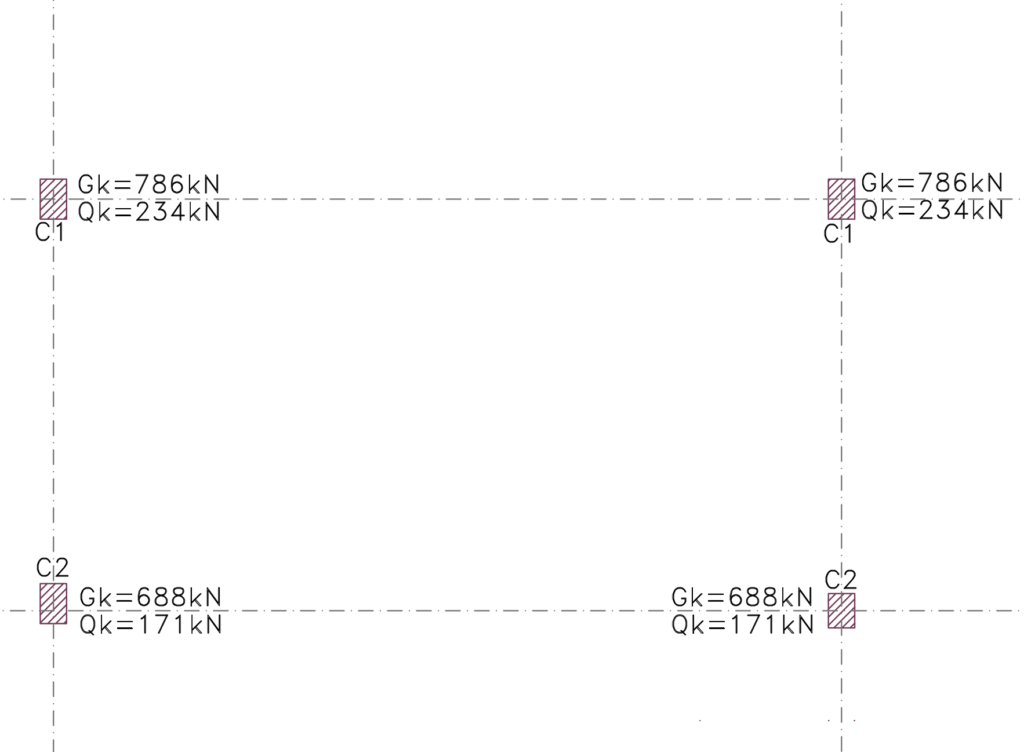
| Pit | Depth (m) | C (kN/m2) | (°) | γb (kN/m2) | Nc | Nq | Nγ | qf (kN/m2) | F.O.S | qa (kN/m2) |
|---|---|---|---|---|---|---|---|---|---|---|
| TP1 | 1.5 | 4.56 | 29.3 | 17.1 | 28.5 | 17.0 | 20.2 | 402.8 | 3 | 134.3 |
| TP2 | 1.5 | 2.80 | 30.4 | 15.1 | 31.2 | 19.3 | 23.8 | 309.2 | 3 | 103.1 |
| TP3 | 1.5 | 4.66 | 29.4 | 17.3 | 28.8 | 17.2 | 20.5 | 417.9 | 3 | 139.3 |
| TP4 | 1.5 | 8.74 | 28.3 | 16.8 | 26.4 | 15.2 | 17.4 | 497.5 | 3 | 165.8 |
| TP5 | 1.5 | 6.36 | 29.2 | 17.0 | 28.3 | 16.8 | 19.9 | 461.6 | 3 | 153.9 |
| TP6 | 1.5 | 16.45 | 28.0 | 17.6 | 25.8 | 14.7 | 16.7 | 763.8 | 3 | 254.6 |
- Pad foundation is recommended for the development, based on an assumed maximum column load of 600kN. Albeit, the structural engineers have been granted the discretion of determining the foundation type.
- A bearing capacity of 100kN/m2 is recommended at a depth of 1.5m
- Based on proposed loading, a settlement of 92mm is anticipated.
- Due to the silty nature of the soil, adequate provisions should be provided to take care of drainage conditions
Given that we already have the safe bearing capacity as 100kN/m2, the process of sizing this foundation is pretty straight forward. Divide the structural loads by the safe bearing capacity and you have the required sizes of the pad footings. When we do this, we get the pad footing for column C1 as (3.4m x 3.4m) and for column C2 as (3.1m x 3.1m). This would appear to have solved the problem as far as geotechnical aspect of designing these spread footings is involved. Well, not until we consider the irregularities in the geotechnical investigation report.
Observations
First, the geotechnical engineer seemed to have drawn his conclusion on the safe bearing capacity for the entire site based solely on the result from the worst test pit (TP2) while there were significantly higher bearing capacity values from other test pits.
Secondly, is the assumption that the maximum column load is 600kN while the actual maximum column loads from structural analysis show a significantly higher value – 1020kN. The implication, therefore, is an issue in the bearing capacity and corresponding settlement computation. For instance, the third component of the Terzaghi equation requires the width of the footing for the computation of the bearing capacity. But, since assumptions are based on the assumed maximum loading, the bearing capacity values turns out incorrect.
Thirdly, is about the global factor of safety. For this project the designer has decided to apply a global factor of safety of 3 to obtain the safe bearing capacity value.
Pressure Verification to Eurocode
We are going to attempt to size the foundation using Eurocode 7, to see if we can justify an increase in the bearing capacity values.
The procedure follows a “cut and try,” a contrast from the usual approach of estimating the base area required using the safe bearing capacity. Here, the pad footings are sized based on reasonable assumptions, after which a bearing pressure verification is carried out to ensure that the bearing resistance is higher than the applied pressures. The process of carrying out this verification has already been outlined in an earlier article. (See: Geotechnical Design of Spread Foundations to EC7).
Foundation-analysisThe Tab above shows the result obtained from sizing the foundation using the data from the worst test pit (TP2). For a (2.0m x 2.0m) base, the applied pressure is 300.6kN/m2 while the allowable bearing resistance is 515.7kN/m2 with a cautious utilization ratio of 0.583. Perhaps, no explanation is required to understand why the footing size has drastically reduced. But there is more; the requirement to check ground deformation.
Settlement Verification to Eurocode
The serviceability limit state of settlement is adequate if the following inequality is satisfied.
{E}_{d}\le{C}_{d}Where:
- Ed is the total settlement, which typically contain three components – immediate settlement, consolidation settlement and creep settlement.
- Cd is the limiting value of settlement taken as (50-75mm) for foundations in sand and (75-135mm) for clays3.
There are several methods of estimating the total settlement, the most commonly recognized method is the stress strain method, whereby the strain is computed from the stress induced and soil moduli and then subsequently integrated to obtain the settlement. This procedure is quite tedious when done by hand, thus many geotechnical commercial software are now available, integrating the process.
For this problem, the maximum settlement when a footing size of (2.0m x 2.0m) is adopted was analyzed using Geo5-Spread Footing. Figure 4 presents the results obtained from the settlement analysis. A maximum value of 20.3mm was obtained.
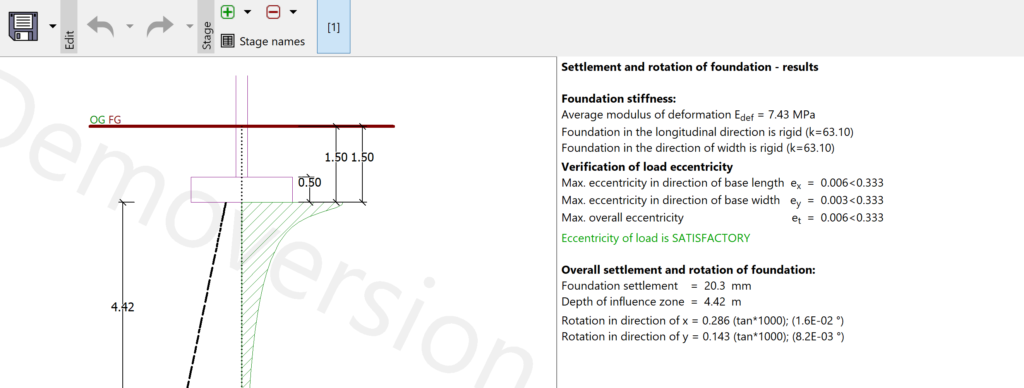
Conclusion
Does Eurocode 7 justify higher bearing capacity values? The design study answers in the affirmative. The design study shows that geotechnical design carried out, exercising the working stress method can yield uneconomical solutions because, global factors of safeties are assumed and thus, sometimes, overly conservative.
Furthermore, it is a well-accepted view that foundation sizing falls entirely within the remit of geotechnical engineers, with the structural engineer only carrying out structural design checks such as specifying concrete grade and reinforcement requirement. The workflow requires the structural engineer to furnish the geotechnical engineer with the structural loads in advance in order to determine the required footing sizes. However, the practice in Nigeria has mostly been the opposite. The geotechnical engineer goes ahead to conduct a site investigation, make assumptions on expected loading and on the same basis, conclude on the safe bearing capacity value and foundation type.
It is this writer’s view, that the idea of writing safe bearing capacity values in geotechnical reports based on “presumed data” is a lazy approach to foundation design. It does not justify the cost of conducting site investigations since there are presumed bearing capacity values in reports which can easily be used to produce conservative designs. The essence of a geotechnical investigation is to establish as precise as practicable, the actual soil conditions of a site. This purpose stands defeated when inaccurate assumptions are made. Eurocode 7 deals positively with this, by harmonizing geotechnical design with structural design through the introduction of a consistent safety requirement, coherent partial factors and a common design methodology – the limit state design philosophy.
Foundation design using the Eurocodes is a lesson on what can be achieved when there is a collaborative effort between the structural engineer and the geotechnical engineer. Instead of writing safe bearing capacity values in geotechnical reports, can we have the footing sizes?
Citations
- Bond A and Harris A (2008) Decoding Eurocode 7. Taylor & Francis, London, UK.
- Institution of Structural Engineers (2013) Manual for the Geotechnical Engineers of Structures to EC7.
- Trevor L.L (2012) How Eurocode 7 has affected geotechnical design: a review, Proceedings of the Institution of Civil Engineers – Geotechnical Engineering.
- BSI (1986) BS 8004:1986: Code of practice for foundations. BSI, Milton Keynes, UK.
- BSI (2004b) BS EN 1997-1:2004: Eurocode 7: Geotechnical design – Part 1: General rules. BSI, Milton Keynes, UK.
- BSI (2007a) BS EN 1997-2:2007: Eurocode 7: Geotechnical Design – Part 2: Ground investigation and testing. BSI, Milton Keynes, UK
Well done Victor.
I seems to disagree with some of your assertion in this article. Kindly note that BS 8004 clearly stated global factor of safety for foundation including its practical use.
Thanks